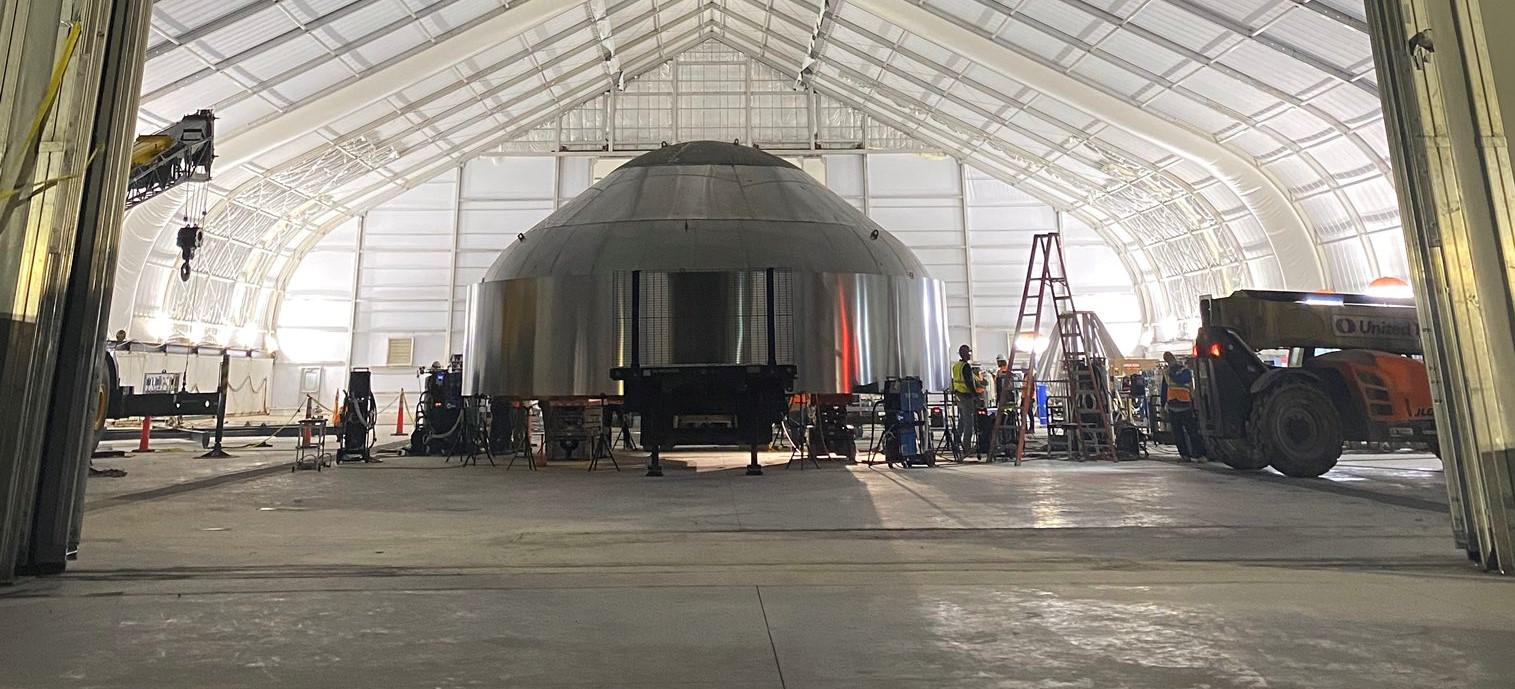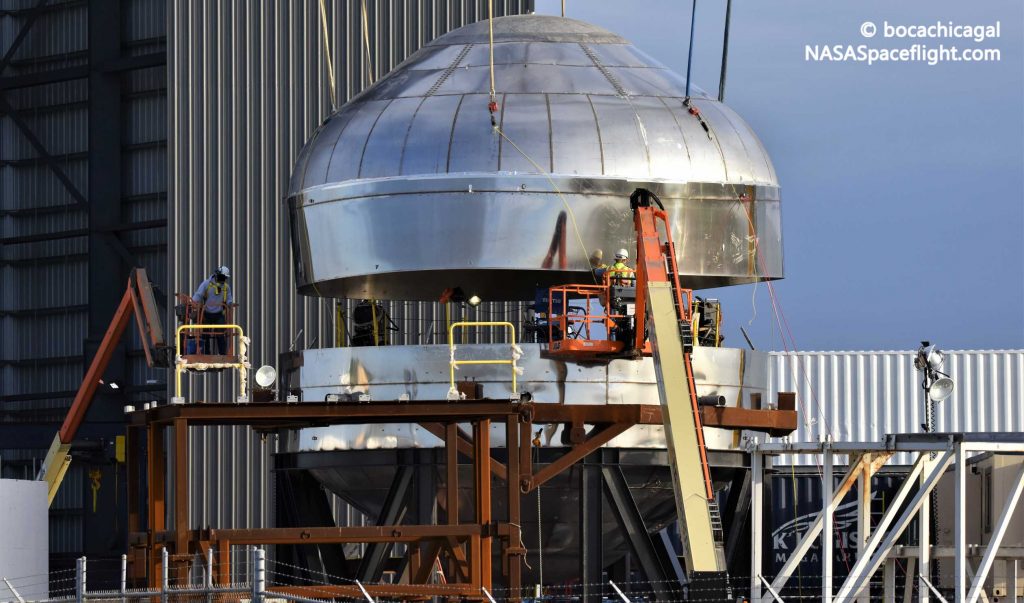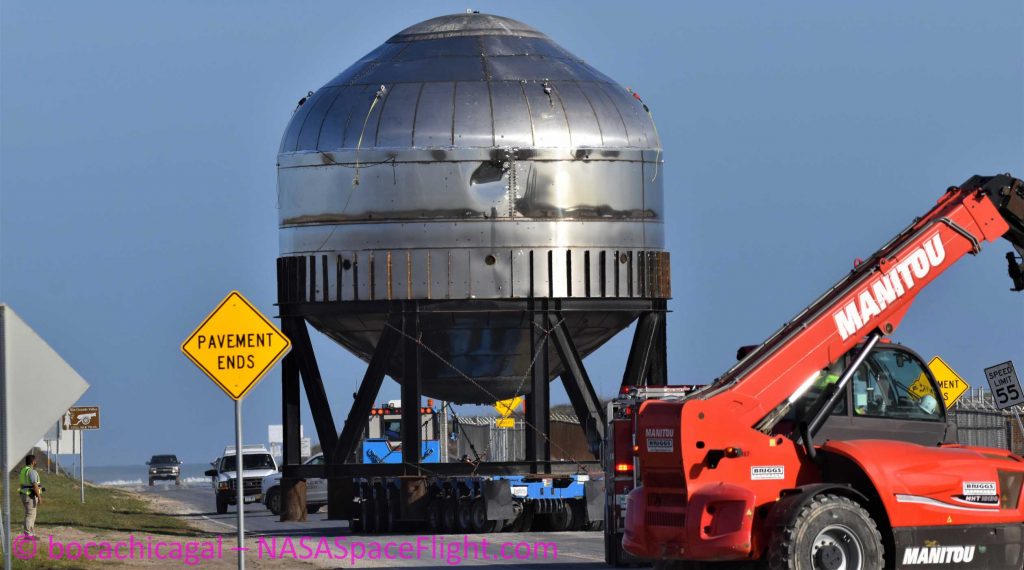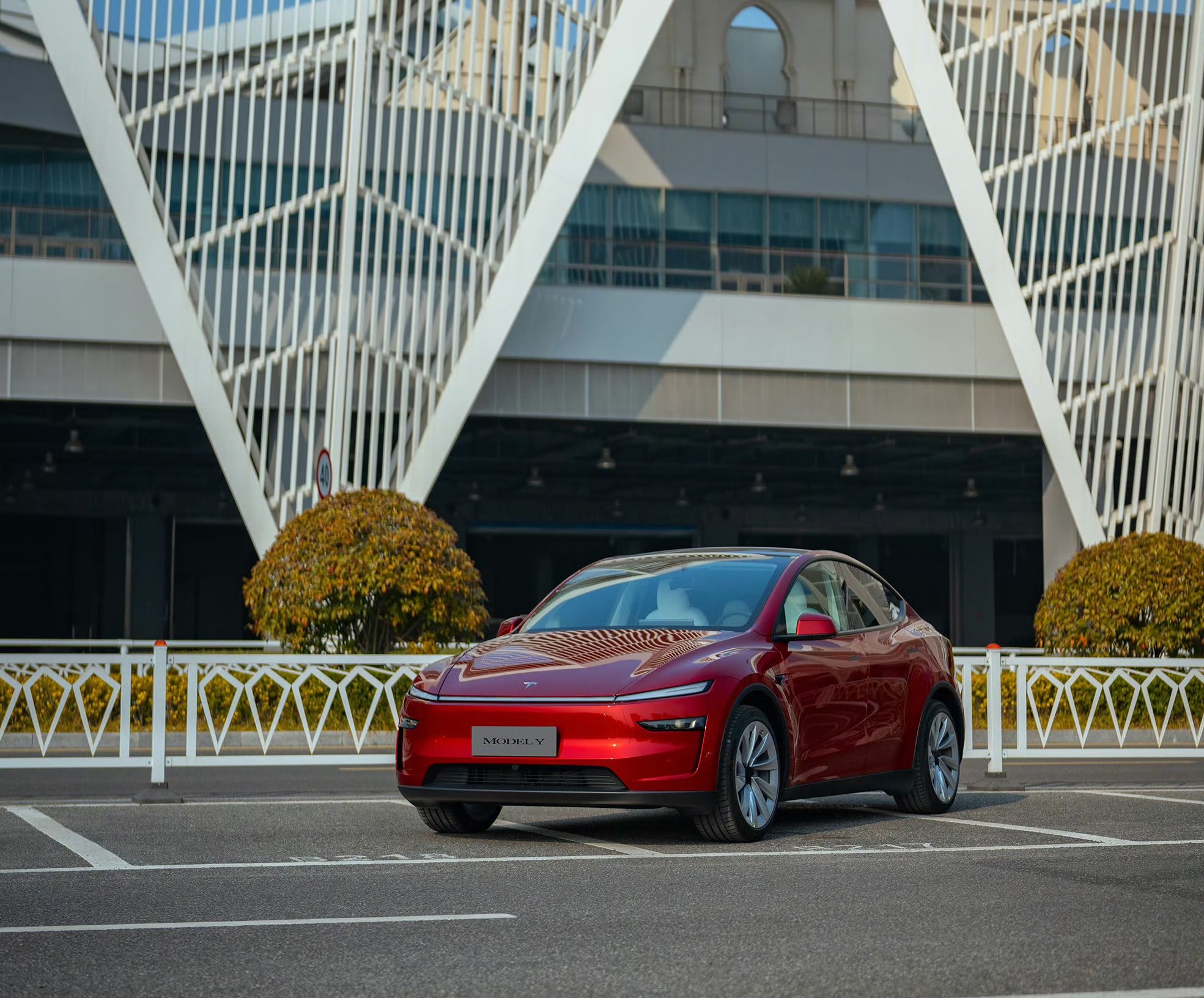

News
SpaceX Starship factory churning out new rocket parts with Elon Musk's help
SpaceX’s South Texas team of Starship engineers and technicians – including CEO Elon Musk himself – are working around the clock to manufacture hardware that will likely become the company’s next Starship prototype in the near future.
Over the last few days, SpaceX has made quick progress churning out shiny steel rings and wrapping up propellant tank domes – the next round of full-scale Starship hardware. To better build the first flight and orbit-capable prototypes, not to mention hundreds or even thousands of Starship spacecraft and Super Heavy boosters in the years to come, SpaceX teams and contractors have spent the last two months aggressively expanding the company’s Boca Chica, Texas facilities. In fact, the very same company that built Tesla’s newest tent-based Model 3 assembly line – Sprung Instant Structures – has erected part of a massive, new Starship factory.
Finally giving the company’s grizzled South Texas team a large, climate-controlled space to work from, CEO Elon Musk has also been spending more and more time at SpaceX’s upgraded Boca Chica facilities. Most recently, the executive gave Twitter followers the first official glimpse inside one of the new Starship production tents, revealing several giant spacecraft parts in various stages of completion. It’s currently unclear what the destiny of that new Starship hardware will be, but a few recent clues seem to point in one specific direction.
Yeah, we just finished two more propellant domes. SpaceX team & supporting suppliers are doing amazing work ramping Starship production.— Elon Musk (@elonmusk) January 22, 2020
On January 10th, SpaceX intentionally – and largely successfully – ‘popped’ a Starship propellant tank to determine the quality of partially-upgraded manufacturing and assembly techniques. Built in just two weeks, Musk revealed shortly after the test that the baby Starship tank – filled with water – had made it to 7.1 bar (103 psi) before bursting.
While fairly meaningless on its own, it apparently means that the test tank survived well past the pressures Starships will need for orbital flight, although it only managed a safety margin of ~18%. To be fully flightworthy, Musk says that SpaceX wants Starship tanks to survive pressures of at least 8.5 bar (125 psi) – a margin of ~40% – before it considers the giant spacecraft safe enough for humans.

Given that the 7.1 bar the test tank reached is more than enough to support “orbital flight”, albeit with a less-than-optimal safety margin, it would be reasonable to assume that SpaceX would choose to immediately green-light the first flightworthy Starship spacecraft, deemed SN01 (serial number 01) by Musk. While that first prototype would thus be unable to launch humans and fulfill its ultimate goal as a Starship, it would give SpaceX experience building a second full-scale prototype (following Mk1) and give the company time to gradually upgrade its production facilities and manufacturing hardware.
Musk sketched out a number of possible improvements even before SpaceX tested its miniature Starship tank to destruction, indicating that “more precise parts” and an enclosed, wind-protected welding shop should be enough to raise Starship’s safety margin to ~40%. A step further down the road, Musk raised autogenous laser welding as a possibility for future production upgrades, although the advanced welding method would require a truly controlled environment and much more precise parts and manufacturing hardware.

In the last 24 hours, SpaceX has filed for a number of road closures for the highway adjacent to its Boca Chica Starship facilities, a sign that some form of rocket hardware transport and testing is imminent. As such, it now seems much more likely that SpaceX has decided to spend at least a few more weeks building and testing a second (and possibly a third) Starship tank prototype before kicking off the production of the next full-scale rocket.
Intriguingly, SpaceX has also received several large shipments of liquid nitrogen (LN2), a neutral cryogenic fluid often used to simulate cryogenic propellants without risking a massive explosion or fire. That LN2 wont last forever in SpaceX’s storage tanks, confirming that some form of cryogenic testing is imminent. The most likely explanation is that SpaceX is in the late stages of manufacturing a second tank prototype, soon to be shipped about a mile down the road to the company’s nearby test and launch facilities.
If SpaceX is planning to perform a burst test with liquid nitrogen, it will likely be quite the spectacle – much closer to Starship Mk1’s spectacular failure than the milder demise of the first miniature Starship tank. SpaceX has roadblocks scheduled every day for the rest of the week, so stay tuned to find out when exactly Starship’s next big test is expected.
Check out Teslarati’s Marketplace! We offer Tesla accessories, including for the Tesla Cybertruck and Tesla Model 3.
Elon Musk
Tesla analysts believe Musk and Trump feud will pass
Tesla CEO Elon Musk and U.S. President Donald Trump’s feud shall pass, several bulls say.

Tesla analysts are breaking down the current feud between CEO Elon Musk and U.S. President Donald Trump, as the two continue to disagree on the “Big Beautiful Bill” and its impact on the country’s national debt.
Musk, who headed the Department of Government Efficiency (DOGE) under the Trump Administration, left his post in May. Soon thereafter, he and President Trump entered a very public and verbal disagreement, where things turned sour. They reconciled to an extent, and things seemed to be in the past.
However, the second disagreement between the two started on Monday, as Musk continued to push back on the “Big Beautiful Bill” that the Trump administration is attempting to sign into law. It would, by Musk’s estimation, increase spending and reverse the work DOGE did to trim the deficit.
Every member of Congress who campaigned on reducing government spending and then immediately voted for the biggest debt increase in history should hang their head in shame!
And they will lose their primary next year if it is the last thing I do on this Earth.
— Elon Musk (@elonmusk) June 30, 2025
President Trump has hinted that DOGE could be “the monster” that “eats Elon,” threatening to end the subsidies that SpaceX and Tesla receive. Musk has not been opposed to ending government subsidies for companies, including his own, as long as they are all abolished.
How Tesla could benefit from the ‘Big Beautiful Bill’ that axes EV subsidies
Despite this contentious back-and-forth between the two, analysts are sharing their opinions now, and a few of the more bullish Tesla observers are convinced that this feud will pass, Trump and Musk will resolve their differences as they have before, and things will return to normal.
ARK Invest’s Cathie Wood said this morning that the feud between Musk and Trump is another example of “this too shall pass:”
BREAKING: CATHIE WOOD SAYS — ELON AND TRUMP FEUD “WILL PASS” 👀 $TSLA
She remains bullish ! pic.twitter.com/w5rW2gfCkx
— TheSonOfWalkley (@TheSonOfWalkley) July 1, 2025
Additionally, Wedbush’s Dan Ives, in a note to investors this morning, said that the situation “will settle:”
“We believe this situation will settle and at the end of the day Musk needs Trump and Trump needs Musk given the AI Arms Race going on between the US and China. The jabs between Musk and Trump will continue as the Budget rolls through Congress but Tesla investors want Musk to focus on driving Tesla and stop this political angle…which has turned into a life of its own in a roller coaster ride since the November elections.”
Tesla shares are down about 5 percent at 3:10 p.m. on the East Coast.
Elon Musk
Tesla scrambles after Musk sidekick exit, CEO takes over sales
Tesla CEO Elon Musk is reportedly overseeing sales in North America and Europe, Bloomberg reports.

Tesla scrambled its executives around following the exit of CEO Elon Musk’s sidekick last week, Omead Afshar. Afshar was relieved of his duties as Head of Sales for both North America and Europe.
Bloomberg is reporting that Musk is now overseeing both regions for sales, according to sources familiar with the matter. Afshar left the company last week, likely due to slow sales in both markets, ending a seven-year term with the electric automaker.
Tesla’s Omead Afshar, known as Elon Musk’s right-hand man, leaves company: reports
Afshar was promoted to the role late last year as Musk was becoming more involved in the road to the White House with President Donald Trump.
Afshar, whose LinkedIn account stated he was working within the “Office of the CEO,” was known as Musk’s right-hand man for years.
Additionally, Tom Zhu, currently the Senior Vice President of Automotive at Tesla, will oversee sales in Asia, according to the report.
It is a scramble by Tesla to get the company’s proven executives over the pain points the automaker has found halfway through the year. Sales are looking to be close to the 1.8 million vehicles the company delivered in both of the past two years.
Tesla is pivoting to pay more attention to the struggling automotive sales that it has felt over the past six months. Although it is still performing well and is the best-selling EV maker by a long way, it is struggling to find growth despite redesigning its vehicles and launching new tech and improvements within them.
The company is also looking to focus more on its deployment of autonomous tech, especially as it recently launched its Robotaxi platform in Austin just over a week ago.
However, while this is the long-term catalyst for Tesla, sales still need some work, and it appears the company’s strategy is to put its biggest guns on its biggest problems.
News
Tesla upgrades Model 3 and Model Y in China, hikes price for long-range sedan
Tesla’s long-range Model 3 now comes with a higher CLTC-rated range of 753 km (468 miles).

Tesla has rolled out a series of quiet upgrades to its Model 3 and Model Y in China, enhancing range and performance for long-range variants. The updates come with a price hike for the Model 3 Long Range All-Wheel Drive, which now costs RMB 285,500 (about $39,300), up RMB 10,000 ($1,400) from the previous price.
Model 3 gets acceleration boost, extended range
Tesla’s long-range Model 3 now comes with a higher CLTC-rated range of 753 km (468 miles), up from 713 km (443 miles), and a faster 0–100 km/h acceleration time of 3.8 seconds, down from 4.4 seconds. These changes suggest that Tesla has bundled the previously optional Acceleration Boost for the Model 3, once priced at RMB 14,100 ($1,968), as a standard feature.
Delivery wait times for the long-range Model 3 have also been shortened, from 3–5 weeks to just 1–3 weeks, as per CNEV Post. No changes were made to the entry-level RWD or Performance versions, which retain their RMB 235,500 and RMB 339,500 price points, respectively. Wait times for those trims also remain at 1–3 weeks and 8–10 weeks.
Model Y range increases, pricing holds steady
The Model Y Long Range has also seen its CLTC-rated range increase from 719 km (447 miles) to 750 km (466 miles), though its price remains unchanged at RMB 313,500 ($43,759). The model maintains a 0–100 km/h time of 4.3 seconds.
Tesla also updated delivery times for the Model Y lineup. The Long Range variant now shows a wait time of 1–3 weeks, an improvement from the previous 3–5 weeks. The entry-level RWD version maintained its starting price of RMB 263,500, though its delivery window is now shorter at 2–4 weeks.
Tesla continues to offer several purchase incentives in China, including an RMB 8,000 discount for select paint options, an RMB 8,000 insurance subsidy, and five years of interest-free financing for eligible variants.
-

 Elon Musk1 day ago
Elon Musk1 day agoTesla investors will be shocked by Jim Cramer’s latest assessment
-

 News6 days ago
News6 days agoTesla Robotaxi’s biggest challenge seems to be this one thing
-

 News2 weeks ago
News2 weeks agoTesla’s Grok integration will be more realistic with this cool feature
-

 Elon Musk2 weeks ago
Elon Musk2 weeks agoElon Musk slams Bloomberg’s shocking xAI cash burn claims
-

 News2 weeks ago
News2 weeks agoTesla China roars back with highest vehicle registrations this Q2 so far
-

 News2 weeks ago
News2 weeks agoTexas lawmakers urge Tesla to delay Austin robotaxi launch to September
-

 News2 weeks ago
News2 weeks agoTesla dominates Cars.com’s Made in America Index with clean sweep
-

 Elon Musk1 week ago
Elon Musk1 week agoFirst Look at Tesla’s Robotaxi App: features, design, and more














